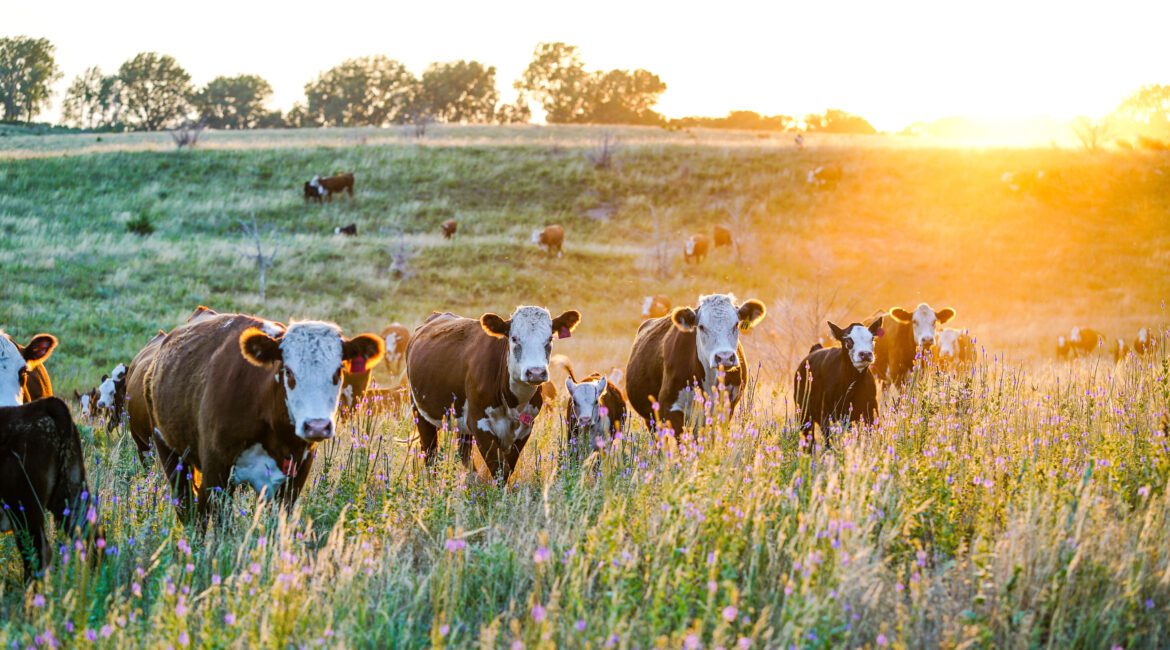This is the third installment of our series on sustainable farming practices, where we take a closer look at how each practice can bring long-term economic and environmental benefits.
Livestock owners: What if you could make more money with fewer animals? It may seem counterintuitive, but with rotational grazing, it’s possible.
Rotational grazing is just as it sounds. Instead of letting livestock continuously graze across a pasture, the pasture is split into smaller paddocks, which the animals are rotated through.
This change in grazing can have big payoffs. In Virginia, livestock owners saw net profits increase $200 per head. Beef Magazine reported that in the first 3.5 years of a USDA study comparing continuous grazing to rotational grazing on a Texas ranch, rotational grazing resulted in a $1,170 per year average return, while traditional grazing lost $80 per year. These differences were seen even though the rotational grazing plot reduced the number of cows from 50 to 30.
The key to rotational grazing’s economic success is its sustainability, which benefits not only livestock owners’ pocketbooks, but also the soil and environment.
Healthier Plants, Healthier Soils
For starters, rotational grazing is healthier pastures. In continuous grazing systems, animals tend to stick to their preferred plants, resulting in uneven grazing distribution, says South Dakota State University (SDSU). Repeated grazing of certain areas can result in bare soil, since the plants don’t have time to recuperate, increasing the odds of soil erosion. It also increases the number of undesirable grasses and weeds, and results in poor manure distribution.
Rotating livestock through smaller paddocks not only ensures more even grazing and natural fertilization but gives the grazed areas time to rest. University of Kentucky (UK) says these rest periods result in forage plant regrowth, renewed carbohydrate stores and improved yield and persistence. It also increases their drought resistance. The root systems of rotationally grazed plants are larger and healthier, so they can reach deeper for water.
Rotational grazing also benefits the soil. A recent study found that soils under adaptive multi-paddock grazing (AMP) management — a form of rotational grazing where livestock density and paddock grazing time are carefully controlled — had 13% more carbon and 9% more soil nitrogen compared to conventional grazing. The carbon also shifted to more persistent organic matter, which suggests long-term carbon storage.
Input Savings
The benefits provided to plants and soils from rotational grazing translate into financial savings for producers. In that USDA comparison study, the rotational grazing treatment saw significant savings in feed and fertilizer — around $6,200 and $4,500 less, respectively, than the traditional grazing plot.
Feed savings can come from an increase in grazing days. SDSU recently surveyed South Dakota cattle ranchers and found those who continuously graze average 182 grazing days, while those with a simple rotational system average 197 days. Ranchers who do intensive rotational grazing, where cows are rotated more often, saw the greatest grazing period with an average 235 days.
Rotational grazers can also save on fertilizer costs. Mississippi State University Extension says you can reduce recommended nitrogen rates by 20% for the same yield goal. It also improves the effective nitrogen application rate from cattle urine. Rotational grazing sees an effective nitrogen application rate of 30-50 pounds per acre per year from cattle urine, whereas under continuous grazing it’s less than 1 pound. MSU Extension says that just a twice weekly rotation could add around 20 pounds of available urinary nitrogen per acre per week.
Getting Started with Rotational Grazing
The good news is that this management system can be designed to fit your needs. UK recommends starting with one pasture and dividing it in half. If you see an improvement, divide it again or try dividing another pasture. It may take several years to figure out the right design and rotation frequency. The university recommends using temporary fencing and portable watering tanks to experiment with different paddock sizes and watering systems.
The initial investment to do rotational grazing also varies by farm size. SDSU says that for ranches of less than 100 acres, the cost of fencing and watering stations may cost $70 per acre, while those with at least 400 acres may see costs lowered to less than $10 per acre.
Conterra Ag lends exclusively to American agriculture and has expertise in a variety of farm and ranch operations utilizing both traditional and sustainable farming practices. If you are ready to refinance, or looking to grow your operation, let’s talk ag — contact your Conterra relationship manager today.





